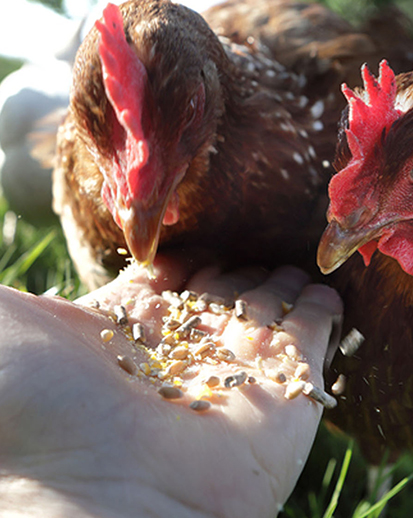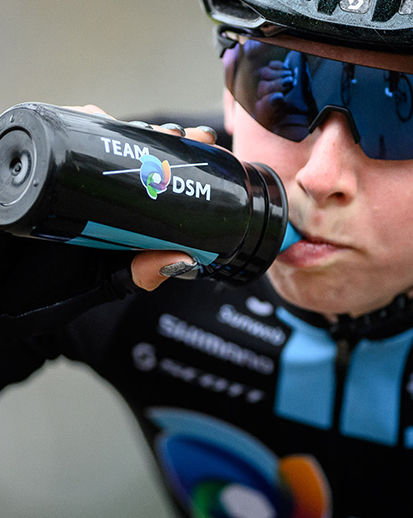If we hope to feed, sustainably and responsibly, the 9.7 billion1 people who are expected to share our planet by 2050, the time to change is now. While plant-based proteins show increasing potential for helping to meet this need in a sustainable manner, they are not sufficient to fulfill it completely, and animal-based proteins retain an essential role in meeting global dietary requirements. We see many opportunities to improve and are therefore helping to make animal farming more sustainable so we can bring better food, nutrition and health to all, within planetary boundaries.
The need for sustainable animal protein production
Animal-based proteins are highly nutritious and form a key part of a balanced, healthy diet. Their consumption is also central to many cultures, and animal-source foods and other animal-source products play an important socio-economic role in those cultures.
However, rising demand for animal protein is driving up greenhouse gas emissions and piling pressure on natural resources. The sustainability of mainstream animal production is consequently coming under increasing scrutiny from the value chain, policy makers and associated stakeholders.
Continuing to operate as we have done in the past is not an option. All players involved in the production of animal protein need to be aware of the challenges we are facing. We must work together to solve them – applying new thinking, new technologies, and new business models in order to create a more sustainable industry for the whole planet.
Our solutions
We embed sustainability as a business driver and enable our customers and partners to deliver sustainable and healthy solutions for the planet and society. We are building a sustainable future in six key areas:
- Improving the lifetime performance of farm animals
- Making efficient use of natural resources
- Reducing emissions from livestock
- Helping tackle antimicrobial resistance
- Reducing our reliance on marine resources
- Improving the nutritional quality of meat, milk, fish and eggs, while reducing food loss and waste
Our innovative science-based solutions enhance the animal nutrition value chain at every stage. This involves enabling farmers to develop practices that are both sustainable and economically viable. Here we highlight our contribution to one of these: reducing emissions from livestock.
Do you know?
Animal farming accounts for what percentage of all human-derived greenhouse gas emissions?
14.5% of all human-derived greenhouse gas emissions
Our impact: reducing emissions from livestock
Creating a low-emissions future for animal farming
Animal farming accounts for 14.5% of all human-derived greenhouse gas (GHG) emissions. This figure is set to rise as demand for animal-source foods increases. It needs to be reduced rapidly to limit the rise in global temperatures to 1.5°C by 2050. The main sources of these emissions relate to animal feed, followed by methane naturally produced by cows, and then again by methane plus nitrous oxide emissions from manure.
Reducing emissions through nutrition
Reducing emissions entails, among other things, changes to farm infrastructures and husbandry practices, but improvements in nutrition are of pivotal importance. To be sustainable in the long term, animal farming has to reduce the emissions it produces, cutting levels of methane, nitrous oxide and ammonia, which drive up global warming and negatively impact biodiversity and water quality. Our innovative nutritional solutions targeting these emissions are Bovaer® (which reduces methane emissions from ruminants by at least 30%), VevoVitall® (which reduces ammonia emissions by up to 18% in swine), and our protease feed enzymes such as ProAct (to improve protein feed protein utilization in poultry and subsequently reduce nitrogen emissions to the environment).

Reducing nitrogen emissions with ProAct
ProAct increases the amount of digestible protein in feed, making it possible to reduce the overall protein content of feed. It improves the digestibility of proteins, thereby reducing nitrogen emissions to the environment by up to 17%.
ProAct also enables the use of more diverse feed raw materials and facilitates greater flexibility in feed formulation, reducing our reliance on soy and thereby helping to cut deforestation for soy cultivation. This equates to an average reduction of 8% (25kg) in the amount of soybean meal required per ton of broiler feed. If ProAct were to be used globally in broiler diets, it would permit the replacement of 7.2 million tons of soybean meal annually, corresponding to 9.0 million tons of soy, thereby reducing deforestation by 3.1 million hectares a year.
Effective measurement is essential to this undertaking, and so we have been developing an advanced sustainability service that enables farmers to see their own environmental footprint in its entirety and understand where changes need to be made for improvement. This service is backed up by science-based, cost-effective solutions to make the improvements a reality. Creating this transparency gives farmers options for reducing their emissions, differentiating themselves from less sustainable competitors and unlocking the real value of sustainable animal production.
Stronger together
We work closely with our customers and other partners in the value chain to make sustainable animal farming possible, and are always looking for ways to increase our positive impact together. For several years now, we have been helping our customers to calculate their carbon footprint (GHG emissions), working with them to reduce it over time by means of practical, proven nutritional solutions to ensure they reach their emissions reduction targets.
We have recently developed a new Animal Protein Sustainability Service (APS Service), which will allow us to holistically evaluate the full environmental footprint of our customers’ animal protein production operations. The APS Service uses highly advanced Life Cycle Assessment (LCA) tools, modeling and benchmarking to produce a powerful business diagnostic for animal protein producers: a large footprint is often associated with inefficiencies in the farming system, and eliminating these can allow the farmer to capture financial value while reducing the farm’s environmental footprint.
How we support the SDGs
2
2 – End hunger, achieve food security and improved nutrition and promote sustainable agriculture
Our products contribute to delivering animal-source foods that are healthy, nutritious, affordable and sustainable by promoting animal health via targeted nutritional interventions.
3
3 – Ensure healthy lives and promote well-being for all at all ages
By supporting the production of healthy, nutritious, affordable and sustainable animal-source foods, we improve the availability of protein, which is a critical macronutrient and an essential component of a balanced diet.
12
12 – Ensure sustainable consumption and production patterns
Our products that increase the digestibility of feed help reduce the area of agricultural land needed to produce essential feed crops, giving farmers options for reducing their emissions and differentiating themselves from less sustainable competitors.
13
13 – Take urgent action to combat climate change and its impacts
Our products that reduce the emissions to air, land and water that are associated with livestock production address climate change and its impacts.
1 Source: UN







